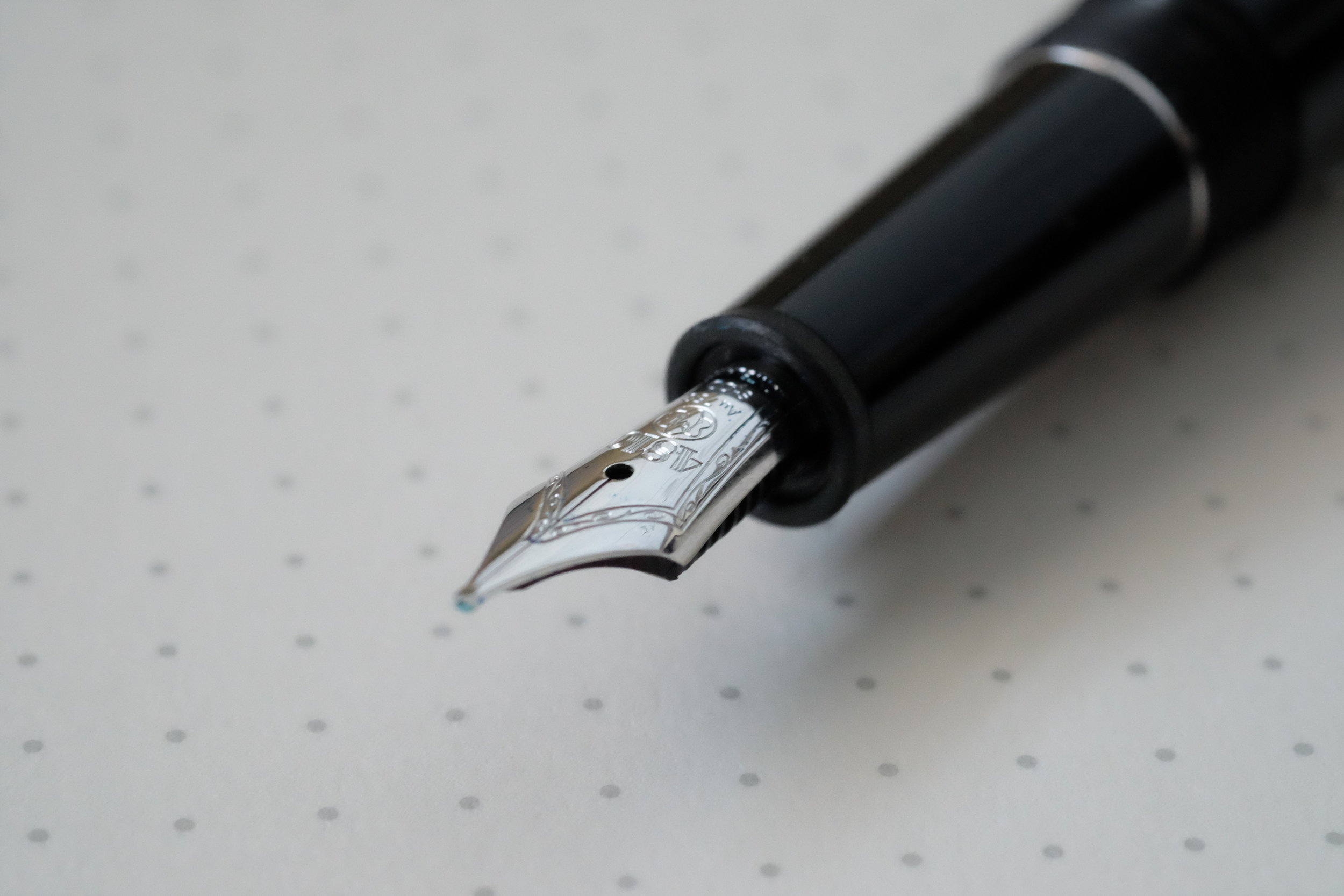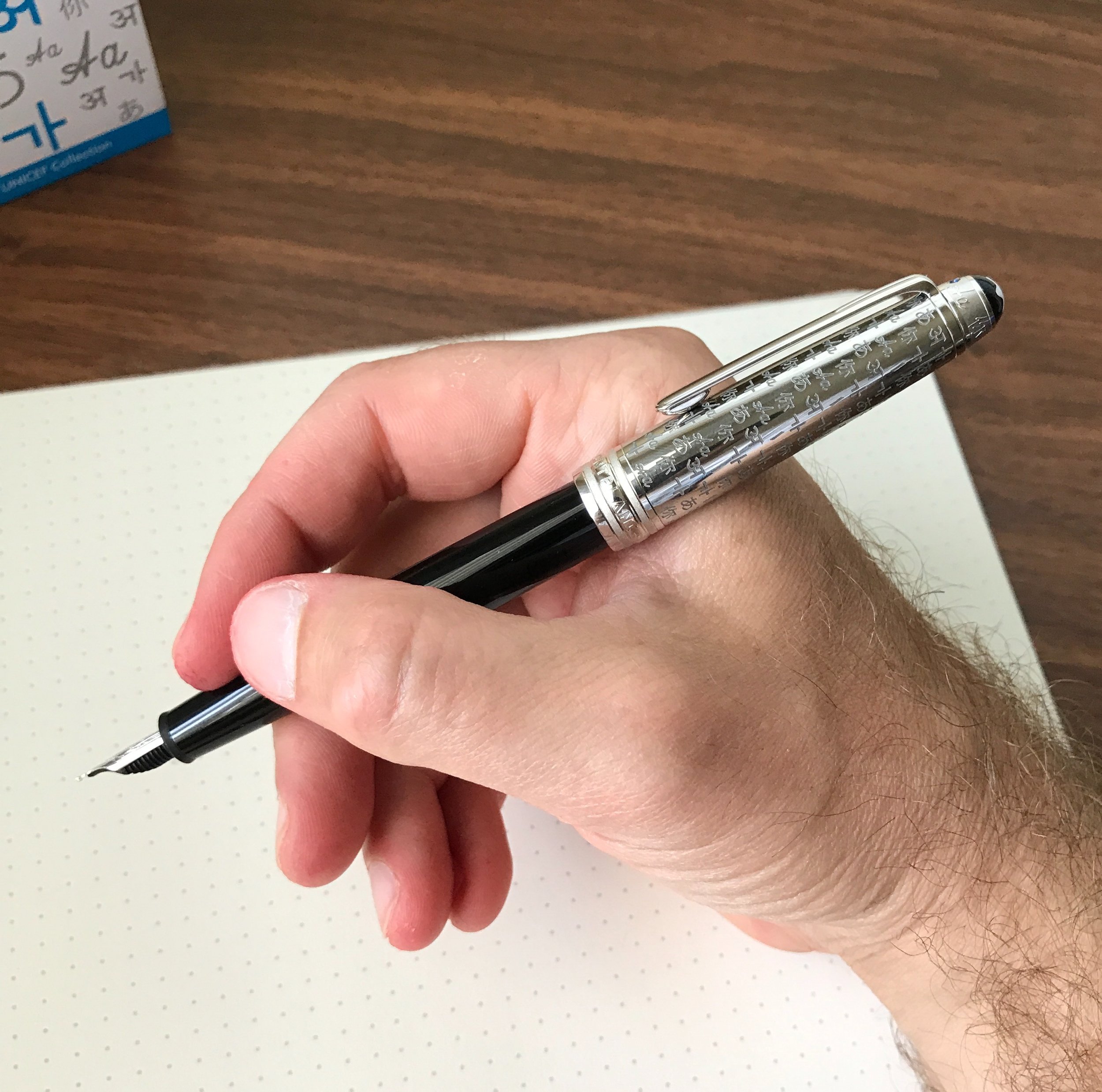Conventional wisdom says that as you fall deeper and deeper down the stationery rabbit-hole, you start to develop a taste for more expensive products, whether that be a $1000 fountain pen or a $5 pencil. I don’t think that’s necessarily true in the sense that most people think - that you lose your enjoyment for the "simple things" - because I still enjoy a $20 Lamy Safari as much as I do a very expensive pen such as this one, just in a different way. I do think, however, that you start to develop a better sense / appreciation for why certain pens command the pricing that they do, and if your budget allows, become more willing to pay for artistry over pure function. The Montblanc for UNICEF Solitaire Doue is a great example of this.
Background on the Montblanc for UNICEF Line
Before I jump into a review of the pen itself, I wanted to talk a bit about the Montblanc-UNICEF partnership and the idea behind this pen (as well as the other pens in this line and the limited edition ink). UNICEF (short for the United Nations International Children’s Emergency Fund) promotes the rights and wellbeing of children around the world, especially those in impoverished and/or war-torn areas. Montblanc has partnered with UNICEF for years to raise money and awareness - more than $10 million since 2004 - but as far as I know this is the first time Montblanc has released any sort of UNICEF-themed product.
All of the Montblanc for UNICEF pens feature an inlaid sapphire.
In April, Montblanc and UNICEF announced that they would be continuing their partnership. Montblanc’s collaboration with UNICEF focuses on providing access to education, with a particular focus on helping children learn to read and write. Around the same time, Montblanc released a new line of UNICEF-themed pens, as well as a limited edition “UNICEF blue” bottle of ink. Montblanc donates a portion of the proceeds from the sale of these products to UNICEF.
“Montblanc, in partnership with UNICEF, aims to improve learning conditions for over 5 million children around the world by providing quality learning materials and better teaching. ”
The Montblanc website sets out the full details of the promotion: “Unicef does not endorse any brand or product. For every piece in the ‘Montblanc for UNICEF Collection’ sold from April 1 2017 to March 31 2018, Montblanc will donate 3% of the proceeds to support UNICEF and its literacy projects, with a minimum amount of $1.5 million being guaranteed by Montblanc.”
3% of each pen sold is not a huge percentage. (To illustrate, 3% would mean that for every $1000 of pen sold, UNICEF would receive $30.) That said, a major aspect of this sort of project is the raising of awareness about the organization, and kudos to Montblanc for choosing UNICEF. I’d also note that Montblanc does not appear to be making money off of a “UNICEF markup.” The pricing is similar, if not a bit lower, than their other “Solitaire Doue” limited editions such as the “Blue Hour”. Given the UNICEF model's platinum plating and trim, inlaid sapphire, and the intricate design and workmanship, this is, in all likelihood, an expensive pen for Montblanc to make and my guess is that the overall profit margin is slim. I’m not at all trying to cast shade on the Montblanc-UNICEF collaboration or any other corporate-charity partnership. UNICEF has been partnering with Montblanc for more than a dozen years, so one can only assume they find the collaboration valuable. The only reason I mention the “real numbers” behind the special edition is because (1) I know people are going to ask, and (2) someone shouldn’t purchase this pen thinking that he or she is making a $1000 contribution to UNICEF. If that’s what you want to do, you’re better off donating to UNICEF directly, and I’d invite you to visit the organization’s webpage to learn more about it.
A Design Inspired by the Rosetta Stone
The design on the cap is “inspired by the Rosetta Stone, an ancient artifact used to decipher Egyptian hieroglyphics.”
Now, on to the pen itself. The particular model featured in this review is the Solitaire Doue Classique (145). What does that mean? For starters, the 145 signals that it’s Montblanc’s smaller cartridge-converter pen, as opposed to the larger, piston-filling 146 or 149. (It’s not the smallest fountain pen Montblanc makes. That honor goes to the "W.A. Mozart".) From what I can gather, Montblanc uses “Solitaire Doue” to signify that the pen has a metal cap, which on this pen is platinum plated and engraved with the first letter of alphabets / calligraphies from around the world. Like all models in the Montblanc for UNICEF line, the cap also features an inlaid 1.3mm sapphire. With so many different design elements, you might worry that they would clash or look “too busy,” but Montblanc brings them all together very nicely. Overall, this is a very understated and classy writing instrument that I wouldn't hesitate to break out anywhere, especially in a business meeting.
In my opinion, the Montblanc for UNICEF line has some of the better-looking special edition pens that Montblanc has released.
The barrel is Montblanc’s standard polished “precious resin,” with a twist: a metal end cap, which has the effect of nicely balancing the pen when using it unposted. Presumably, the design is inspired by the metal piston nobs that Montblanc has included on certain of its piston fillers, such as the Meisterstuck 146 Ultra Black. I initially wondered why they would include a similar feature on the cartridge-converter Classique, but after writing with this pen I understood. Despite its comparatively small size, the Solitaire Doue Classique is an extremely comfortable writer. The standard all-resin Classique, which I’ve owned in the past, it a touch too light for me to use without posting the cap, which as all Montblanc owners know will scratch the resin over time if you're not careful.
Nib and Writing Experience
The nib on the Solitaire Doue writes a nice wet line, and I had no trouble with ink starvation, hard starts, or skipping. As with my Heritage 1912, the quality control was exceptional.
The UNICEF Solitaire Doue features a rhodium-plated 18k gold nib, which is not only very soft but, to me, slightly stubbish. This particular pen has a fine nib that writes more like a medium. I’d compare it favorably to the nib on my Heritage 1912, meaning that it’s soft and offers a touch of line variation, but wouldn't be considered flexible or semi-flex. I’ve personally enjoyed Montblanc’s smaller rhodium-plated nibs more than the larger nibs that appear on the 146 or 149, which tend to be more firm.
The Montblanc for UNICEF Pens Are Accompanied by a Limited Edition UNICEF Ink
Along with the pen, Appelboom sent over a bottle of the limited edition Montblanc for UNICEF Ink, which is UNICEF’s signature turquoise. It’s a beautiful color, which has just a touch of sheen and a lot of depth. Like all Montblanc inks, it flows well, dries quickly, and has limited feathering and bleed. I’ll definitely be picking up a bottle of UNICEF blue in the future, but this particular bottle will be given away on the blog early next week, courtesy of Appelboom!
Takeaways and Where to Buy
The pens in the Montblanc for UNICEF line are easily some of my favorite Montblanc special editions in years, and this particular pen is my favorite of the bunch. Barring some unforeseen major expense disrupting my plans, this pen won’t be making its way back to the Netherlands. I enjoy the design, which serves as a nice conversation piece, and the nib on this pen is nothing short of phenomenal. While they're not within my budget, you may also want to check out several other items in the Montblanc for UNICEF collection, including the UNICEF 146, the Blue Solitaire 146, and the Skeleton 149 models.
You can currently purchase this pen (and the ink!) from Appelboom in Laren, the Netherlands. Pricing with VAT included is $1033; without VAT the price is $855. Appelboom is an authorized Montblanc retailer that carries the full Montblanc line, and can fit your pen with one of Montblanc’s specialty nibs such as an oblique broad (OB), oblique medium (OM), or double broad (BB) if you so desire.
Disclaimer: Appelboom loaned me this pen and the ink free of charge for review purposes. I was not otherwise compensated for this review.



